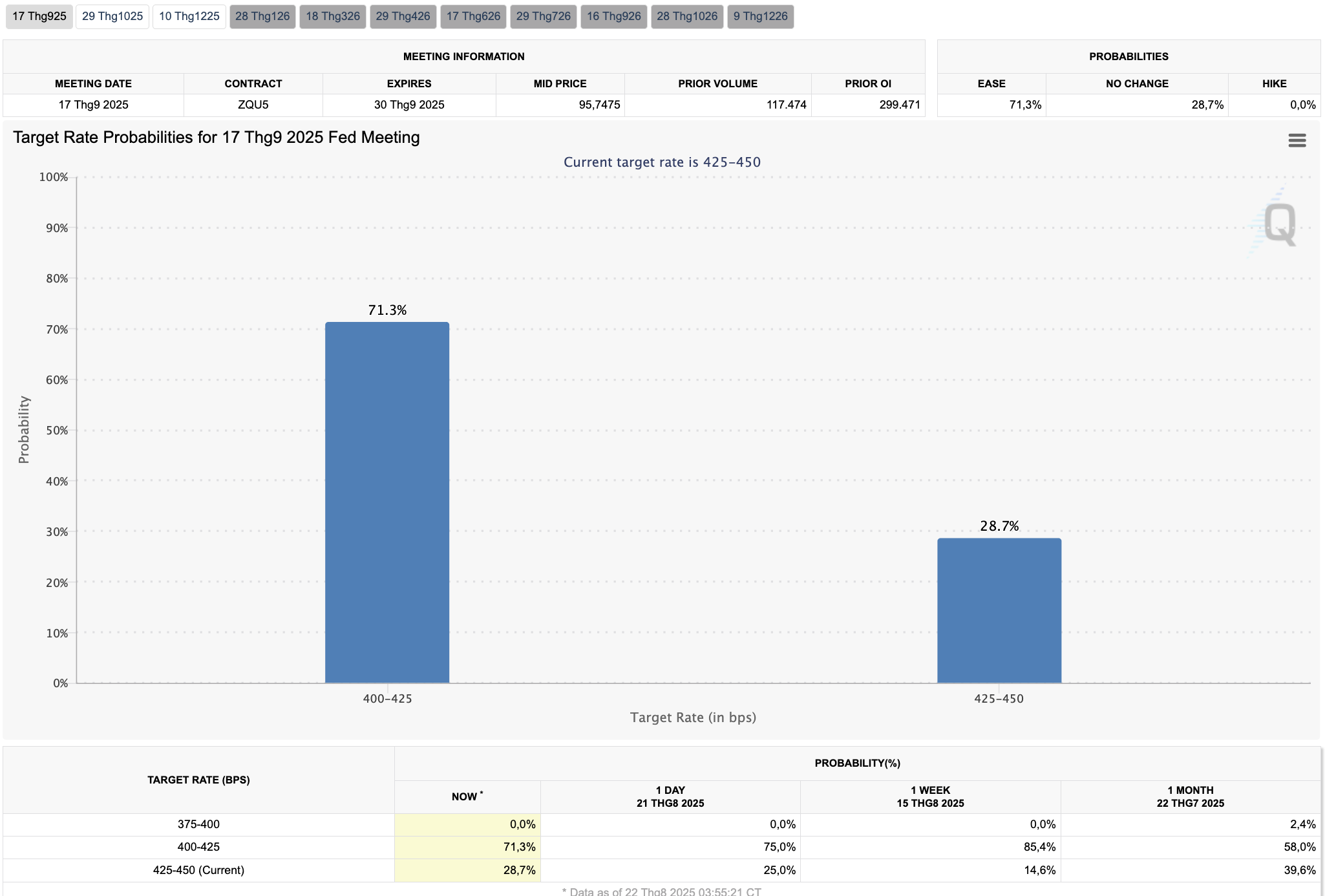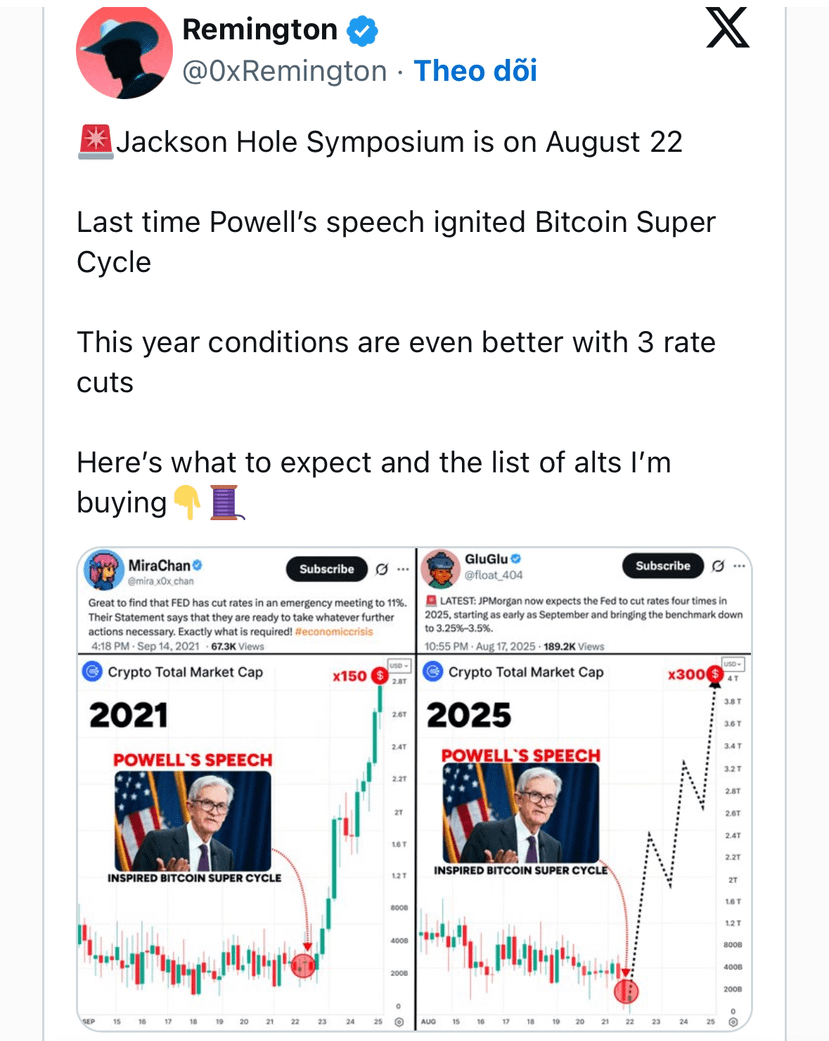For over a decade leading the Federal Reserve Bank of the United States (Fed), Jerome Powell has become one of the most influential figures in the global economy. Each of his statements is not just a policy declaration, but also a signal guiding market expectations. Now, as the Jackson Hole Economic Conference 2025 – an event likened to the 'Oscars of monetary policy' – is about to take place, the financial community is viewing Powell's upcoming speech as a historical moment, which could both reveal the interest rate path and shape his ultimate legacy at the Fed.
Jackson Hole: Where 'one statement' shakes the globe
Jackson Hole has long been a forum where past Fed Chairs send strategic messages, sometimes capable of shifting the course of the global economy. This importance stems from the market's absolute trust in the Fed's central role – not only as the central bank of the United States but also as the 'steerer' of international capital flows, where every decision has a chain reaction effect on stocks, bonds, gold, and even cryptocurrency.
Recent history has repeatedly demonstrated that weight: in 2021, a dovish speech from Powell helped calm post-pandemic sentiment, triggering capital flows back into financial markets and even initiating what many call the 'super cycle of Bitcoin'; in 2022, his unexpectedly hawkish tone caused shockwaves, triggering a massive sell-off across both stocks and crypto, indicating that the Fed was willing to sacrifice growth to curb inflation; and by 2024, just one ambiguous statement immediately created mixed reactions, emphasizing that sometimes just a little ambiguity is enough to cause severe market volatility.
Therefore, Jackson Hole 2025 is expected to be more significant than ever, not only because it could be Powell's last appearance at this event as Fed Chair, but also because the Fed is at a crucial juncture: to continue maintaining a tightening policy to curb inflation, or to begin opening up a new cycle of rate cuts to support growth.
Debate at the Fed
Within the Fed, the debate over the direction of interest rates is becoming more heated than ever as viewpoints are sharply divided into two factions.
On one side are the hardline individuals, often referred to as 'hawks', among whom Beth Hammack – President of the Cleveland Fed – notably emphasizes that cutting rates at this time is too early as inflation is still in a 'volatile' state and has not returned to the desired level of stability.
This view has garnered consensus from Jeffrey Schmid of the Kansas City Fed, who warns that hasty policy easing could undermine the Fed's credibility in the fight against inflation and lead to distorted market expectations.
On the contrary, the more dovish faction, represented by Michelle Bowman and Christopher Waller, argues that the Fed needs to maintain flexibility, ready to adjust policies to support economic growth amid the gradual emergence of weakening signals.
This division has left the market in a wait-and-see stance, with data from CME FedWatch showing that investors currently price in a 71.3% chance that the Fed will cut by 0.25% in September, but at the same time keeping open the scenario of the Fed pausing to 'wait for more data' if inflation and employment indicators continue to show unpredictable fluctuations.

Thus, the importance of Jerome Powell's speech lies not only in which side of the debate he will lean towards, but also in how he outlines the long-term framework for monetary policy, thereby influencing market expectations for many years to come.
The potential shift: Goodbye to 'average inflation'?
One of the factors that analysts are particularly interested in at Jackson Hole this year is the possibility that Jerome Powell will announce the end of the Average Inflation Targeting (AIT) policy, which has been in place since 2020. This policy allows inflation to exceed 2% for a period to compensate for a previous phase when inflation was below target.
In theory, AIT provides the Fed with more operational flexibility, but in practice, it has become a focal point of criticism as many believe that this 'too soft' approach contributed to the inflation of the 2021–2023 period exceeding control.
If the Fed officially ends AIT, the message conveyed will be incredibly powerful: a return to a firm commitment to maintaining inflation around 2% – a benchmark considered a 'stable anchor' for long-term market expectations. This is not just a technical adjustment, but can also be seen as a significant mark in Powell's legacy: closing a controversial experimental phase to bring the Fed back to its traditional trajectory.
For the cryptocurrency market, this move could have positive implications. As inflation is 'anchored firmly' and the Fed gradually approaches a rate-cutting cycle, expectations of lower capital costs will drive speculative capital flows seeking profits in riskier assets. This not only benefits technology stocks but also opens up opportunities for Bitcoin and altcoins, which often benefit when investor risk appetite increases.
Market: From defense to waiting for the boost

Just before the Jackson Hole conference, market sentiment has clearly shown a 'defensive' state. In the derivatives market, the demand for risk insurance has surged, as evidenced by options contracts on SPY and Tesla – a sign that investors are concerned about unexpected volatility. In the crypto sector, Bitcoin has sharply dropped below $113,000, breaking a significant technical trendline after a wave of profit-taking, reflecting the cautious mindset of short-term capital flows.
However, amid this risky landscape, the potential for breakout still exists. Analyst Remington points out that the Fed has executed three rate cuts this year, while liquidity in the market is currently at a 'plentiful' level – favorable conditions to initiate a new capital flow cycle. If this scenario comes to fruition, Bitcoin has a real chance of establishing a higher price level, leading to a spillover effect into small-cap altcoins, where returns could be exceptional for investors willing to take risks.

Nevertheless, not everyone shares an optimistic viewpoint. Nic Puckrin from Coin Bureau warns that macroeconomic factors – from conflicting inflation pressures, signs of a weakening job market, to escalating geopolitical tensions – are the real 'headwinds' for risky asset markets, not just the crypto industry. This means that any ambiguity in the message Powell is about to deliver could become a catalyst for significant market volatility, as investor expectations and concerns continue to coexist.
Powell's legacy: A cautious Fed or reform?
Jackson Hole 2025 is becoming the center of attention not only because it could be Powell's final appearance as Fed Chair, but also because it is symbolic: the dialogue between the individual – history – and the global market.
Powell stands at a crossroads. If he chooses caution, the Fed may continue to maintain high interest rates for a longer period, prioritizing macroeconomic stability and preventing the risk of a resurgence in inflation. This approach would reinforce the image of a steadfast Fed Chair who is not reckless, but it also means accepting a dampening of growth momentum and limiting investment flows into risky assets.
Conversely, if Powell chooses the path of reform, such as reshaping the 'dual mandate' between inflation and employment, or abandoning outdated policy frameworks like Average Inflation Targeting (AIT), he will be remembered as a bold reformer – one who is unafraid to rewrite the rules for the next generation of the Fed. This could usher in an era of more flexible policy, reflecting the rapidly changing global economic reality.
Regardless of the direction, the weight of this speech at Jackson Hole transcends the borders of the United States. On Wall Street, each word will shape the sentiment of capital flows and risk appetite. In the bond market, viewed as the 'lifeblood' of global finance, signals from the Fed could immediately reprice interest rate expectations, leading to a spillover effect across all asset classes. And in cryptocurrency, an asset class that is extremely sensitive to liquidity, even a small change in policy direction could initiate or end a growth cycle.
Therefore, Powell's final speech at Jackson Hole is not just a policy event, but also a crossroads of history. The financial world is holding its breath: Will he close his term as a cautious Fed Chair, steadfast in stable legacy, or as a reformer willing to leave a generational mark? The answer will not only determine the direction for the coming months but could also shape the entire decade of monetary policy ahead – and for the market, from Wall Street to Bitcoin, just one word from Powell could create a global shockwave.
